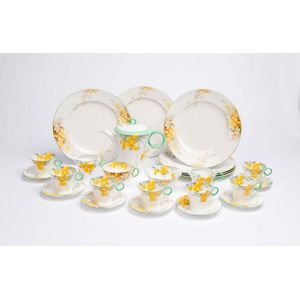Spode Bat-Printed Side Plates, Set of Four
You must be a subscriber, and be logged in to view price and dealer details.
Subscribe Now to view actual auction price for this item
When you subscribe, you have the option of setting the currency in which to display prices to $Au, $US, $NZ or Stg.
- Circa - A Latin term meaning 'about', often used in the antique trade to give an approximate date for the piece, usually considered to be five years on either side of the circa year. Thus, circa 1900 means the piece was made about 1900, probably between 1895 and 1905. The expression is sometimes abbreviated to c.1900.
- Grisaille - Decorative painting in monochrome, usually shades of grey, olive green or buff, painted on wood, plaster, ceramic or stone surfaces to imitate marble figural sculpture or relief ornament.Grisaille, from the French "gris", or grey (colour) is a painting technique in which a monochrome image is created using only shades of gray, black and white, usually created by using a gray underpainting or a limited colour palette. It is often used to create the illusion of sculpture or relief on a flat surface, and was commonly used during the Renaissance and Baroque periods.
The technique of grisaille has been used in decorative arts for centuries. It was commonly used in the Renaissance and Baroque periods in Europe to create the illusion of sculptural relief on flat surfaces such as walls, ceilings, and furniture. This technique allowed artists to create the illusion of depth and dimensionality without the use of colour.
During the Rococo period, grisaille was often used in the production of ceramics and porcelain to create finely detailed designs on a white or light-colored surface.
In the 19th century, grisaille continued to be used in decorative arts, particularly in the production of ceramics, both Western and Oriental.
This item has been included into following indexes:
Visually similar items

A Wedgwood 'April beaded' six piece coffee set, mid 20th century, discontinued 1953, patterns W4144, 5, and 7, the six pieces of identical design but in three colour combinations, apple green, lemon and dove grey, all with solid bands of colour to the rims

Forty eight pieces of Limoges porcelain, comprising a large selection of twenty two white plates, eleven rimmed soup or dessert bowls with associated dishes all edged with a gilt rope design, two white impressed dishes and six plates and a footed dish with

Three Rockingham scenic wares: two plates and a dish, 1826-30 period, pattern 558, the three lightly moulded wares in white with gilt chevron borders and a scrolling border to the cavetto, the interior of each with a painted ruin in a landscape scene, one

Shelley porcelain Wattle pattern Art Deco tea ware and dinner ware, English circa 1920's, comprising teapot, 2 jugs, sugar bowl, 7 cups and saucers, large cup and 6 dinner plates
